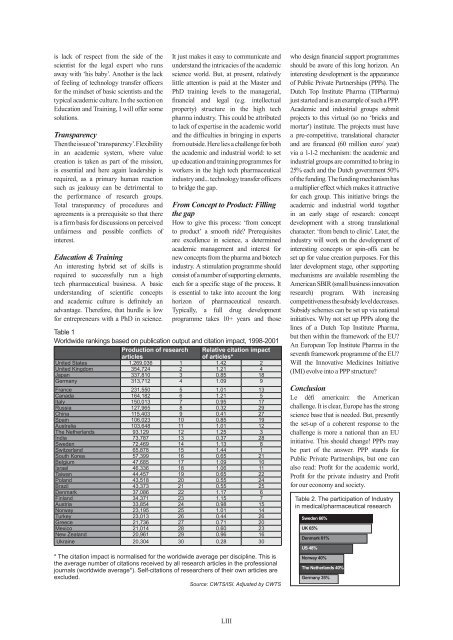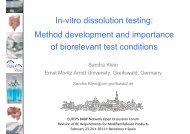2011 Anniversary Yearbook - EUFEPS today and history
2011 Anniversary Yearbook - EUFEPS today and history
2011 Anniversary Yearbook - EUFEPS today and history
Create successful ePaper yourself
Turn your PDF publications into a flip-book with our unique Google optimized e-Paper software.
is lack of respect from the side of the<br />
scientist for the legal expert who runs<br />
away with ‘his baby’. Another is the lack<br />
of feeling of technology transfer officers<br />
for the mindset of basic scientists <strong>and</strong> the<br />
typical academic culture. In the section on<br />
Education <strong>and</strong> Training, I will offer some<br />
solutions.<br />
Transparency<br />
Then the issue of ‘transparency’. Flexibility<br />
in an academic system, where value<br />
creation is taken as part of the mission,<br />
is essential <strong>and</strong> here again leadership is<br />
required, as a primary human reaction<br />
such as jealousy can be detrimental to<br />
the performance of research groups.<br />
Total transparency of procedures <strong>and</strong><br />
agreements is a prerequisite so that there<br />
is a firm basis for discussions on perceived<br />
unfairness <strong>and</strong> possible conflicts of<br />
interest.<br />
Education & Training<br />
An interesting hybrid set of skills is<br />
required to successfully run a high<br />
tech pharmaceutical business. A basic<br />
underst<strong>and</strong>ing of scientific concepts<br />
<strong>and</strong> academic culture is definitely an<br />
advantage. Therefore, that hurdle is low<br />
for entrepreneurs with a PhD in science.<br />
It just makes it easy to communicate <strong>and</strong><br />
underst<strong>and</strong> the intricacies of the academic<br />
science world. But, at present, relatively<br />
little attention is paid at the Master <strong>and</strong><br />
PhD training levels to the managerial,<br />
financial <strong>and</strong> legal (e.g. intellectual<br />
property) structure in the high tech<br />
pharma industry. This could be attributed<br />
to lack of expertise in the academic world<br />
<strong>and</strong> the difficulties in bringing in experts<br />
from outside. Here lies a challenge for both<br />
the academic <strong>and</strong> industrial world: to set<br />
up education <strong>and</strong> training programmes for<br />
workers in the high tech pharmaceutical<br />
industry <strong>and</strong>... technology transfer officers<br />
to bridge the gap.<br />
From Concept to Product: Filling<br />
the gap<br />
How to give this process: ‘from concept<br />
to product’ a smooth ride? Prerequisites<br />
are excellence in science, a determined<br />
academic management <strong>and</strong> interest for<br />
new concepts from the pharma <strong>and</strong> biotech<br />
industry. A stimulation programme should<br />
consist of a number of supporting elements,<br />
each for a specific stage of the process. It<br />
is essential to take into account the long<br />
horizon of pharmaceutical research.<br />
Typically, a full drug development<br />
programme takes 10+ years <strong>and</strong> those<br />
Table 1<br />
Worldwide rankings based on publication output <strong>and</strong> citation impact, 1998-2001<br />
Production of research Relative citation impact<br />
articles<br />
of articles*<br />
United States 1,269,036 1 1.42 2<br />
United Kingdom 354,724 2 1.21 4<br />
Japan 337,810 3 0.85 18<br />
Germany 313,712 4 1.09 9<br />
France 231,550 5 1.01 13<br />
Canada 164,182 6 1.21 5<br />
Italy 150,013 7 0.95 17<br />
Russia 127,965 8 0.32 29<br />
China 115,403 9 0.41 27<br />
Spain 106,023 10 0.85 19<br />
Australia 103,648 11 1,01 12<br />
The Netherl<strong>and</strong>s 93,129 12 1.25 3<br />
India 73,787 13 0.37 28<br />
Sweden 72,469 14 1.13 8<br />
Switzerl<strong>and</strong> 65,878 15 1.44 1<br />
South Korea 57,399 16 0.65 21<br />
Belgium 47,685 17 1.09 10<br />
Israel 46,336 18 1.06 11<br />
Taiwan 44,457 19 0.65 22<br />
Pol<strong>and</strong> 43,518 20 0.55 24<br />
Brazil 43,373 21 0.55 25<br />
Denmark 37,086 22 1.17 6<br />
Finl<strong>and</strong> 34,371 23 1.15 7<br />
Austria 33,854 24 0.98 15<br />
Norway 23,195 25 1.01 14<br />
Turkey 23,013 26 0.44 26<br />
Greece 21,736 27 0.71 20<br />
Mexico 21,014 28 0.60 23<br />
New Zeal<strong>and</strong> 20,961 29 0.96 16<br />
Ukraine 20,304 30 0.28 30<br />
* The citation impact is normalised for the worldwide average per discipline. This is<br />
the average number of citations received by all research articles in the professional<br />
journals (worldwide average*). Self-citations of researchers of their own articles are<br />
excluded.<br />
Source: CWTS/ISI. Adjusted by CWTS<br />
LIII<br />
who design financial support programmes<br />
should be aware of this long horizon. An<br />
interesting development is the appearance<br />
of Public Private Partnerships (PPPs). The<br />
Dutch Top Institute Pharma (TIPharma)<br />
just started <strong>and</strong> is an example of such a PPP.<br />
Academic <strong>and</strong> industrial groups submit<br />
projects to this virtual (so no ‘bricks <strong>and</strong><br />
mortar’) institute. The projects must have<br />
a pre-competitive, translational character<br />
<strong>and</strong> are financed (60 million euro/ year)<br />
via a 1-1-2 mechanism: the academic <strong>and</strong><br />
industrial groups are committed to bring in<br />
25% each <strong>and</strong> the Dutch government 50%<br />
of the funding. The funding mechanism has<br />
a multiplier effect which makes it attractive<br />
for each group. This initiative brings the<br />
academic <strong>and</strong> industrial world together<br />
in an early stage of research: concept<br />
development with a strong translational<br />
character: ‘from bench to clinic’. Later, the<br />
industry will work on the development of<br />
interesting concepts or spin-offs can be<br />
set up for value creation purposes. For this<br />
later development stage, other supporting<br />
mechanisms are available resembling the<br />
American SBIR (small business innovation<br />
research) program. With increasing<br />
competitiveness the subsidy level decreases.<br />
Subsidy schemes can be set up via national<br />
initiatives. Why not set up PPPs along the<br />
lines of a Dutch Top Institute Pharma,<br />
but then within the framework of the EU?<br />
An European Top Institute Pharma in the<br />
seventh framework programme of the EU?<br />
Will the Innovative Medicines Initiative<br />
(IMI) evolve into a PPP structure?<br />
Conclusion<br />
Le défi americain: the American<br />
challenge. It is clear, Europe has the strong<br />
science base that is needed. But, presently<br />
the set-up of a coherent response to the<br />
challenge is more a national than an EU<br />
initiative. This should change! PPPs may<br />
be part of the answer. PPP st<strong>and</strong>s for<br />
Public Private Partnerships, but one can<br />
also read: Profit for the academic world,<br />
Profit for the private industry <strong>and</strong> Profit<br />
for our economy <strong>and</strong> society.<br />
Table 2. The participation of Industry<br />
in medical/pharmaceutical research<br />
Sweden 66%<br />
UK 65%<br />
Denmark 61%<br />
US 48%<br />
Norway 40%<br />
The Netherl<strong>and</strong>s 40%<br />
Germany 35%




